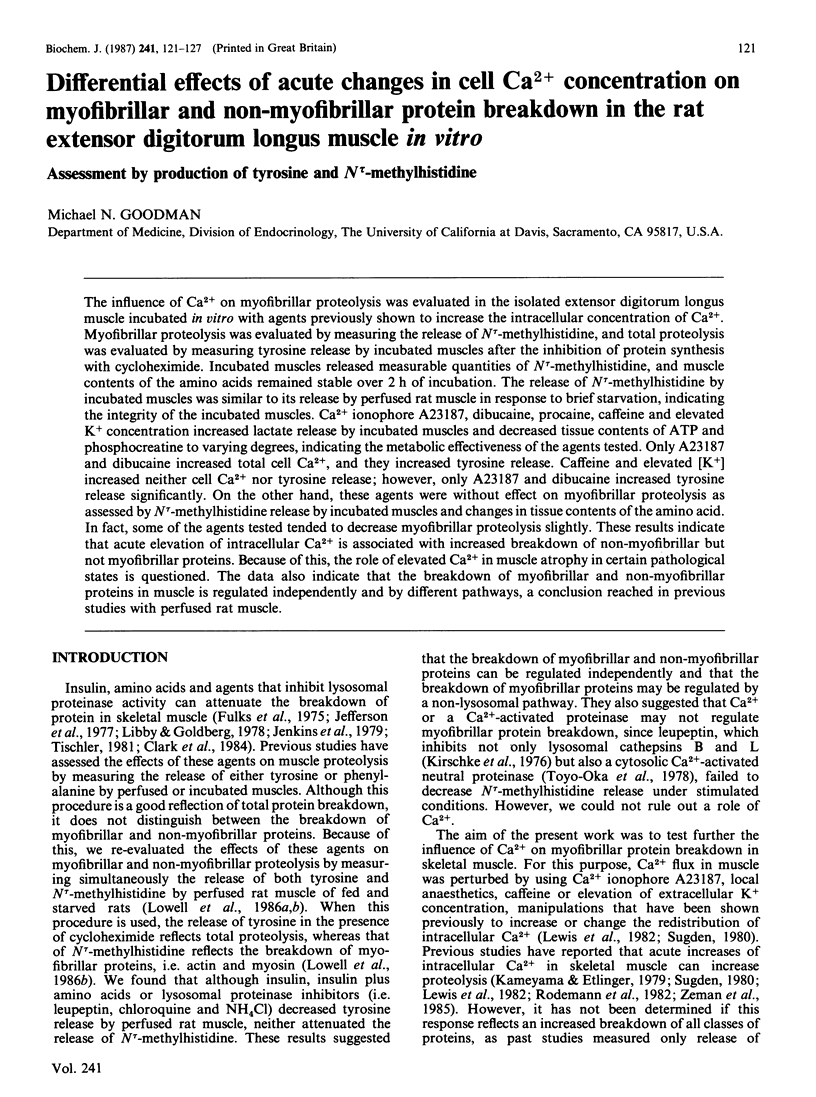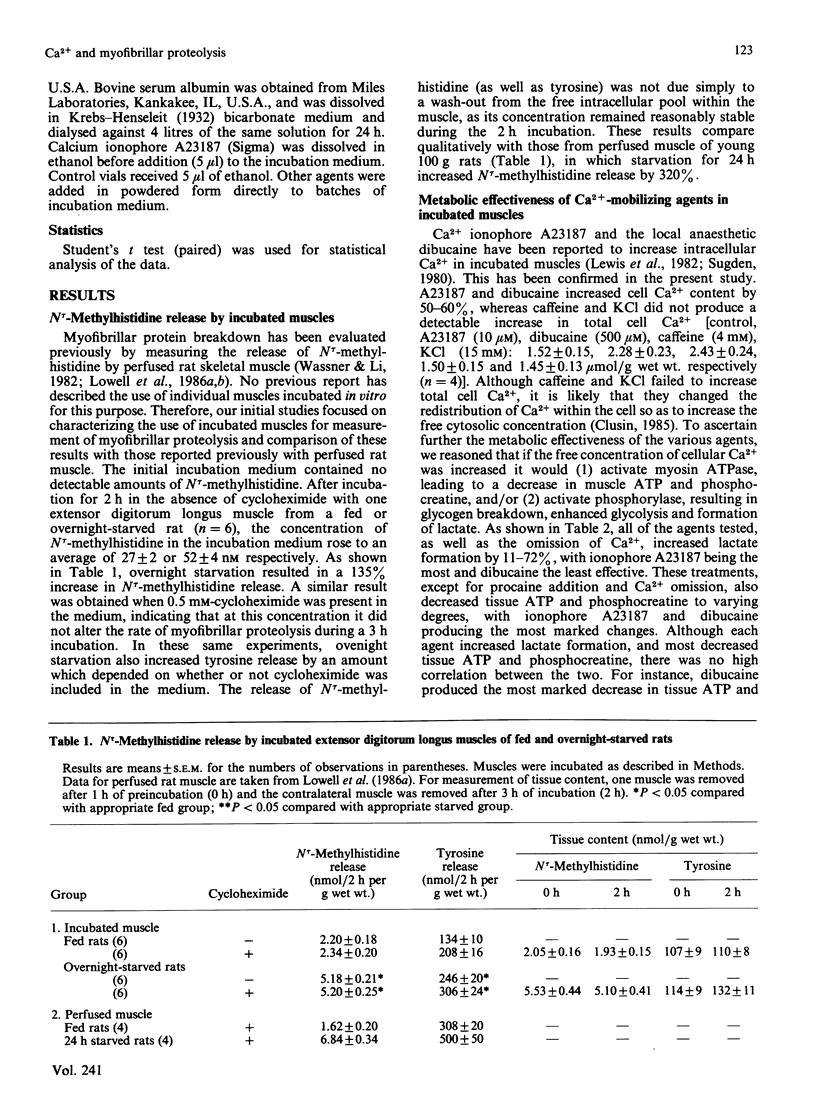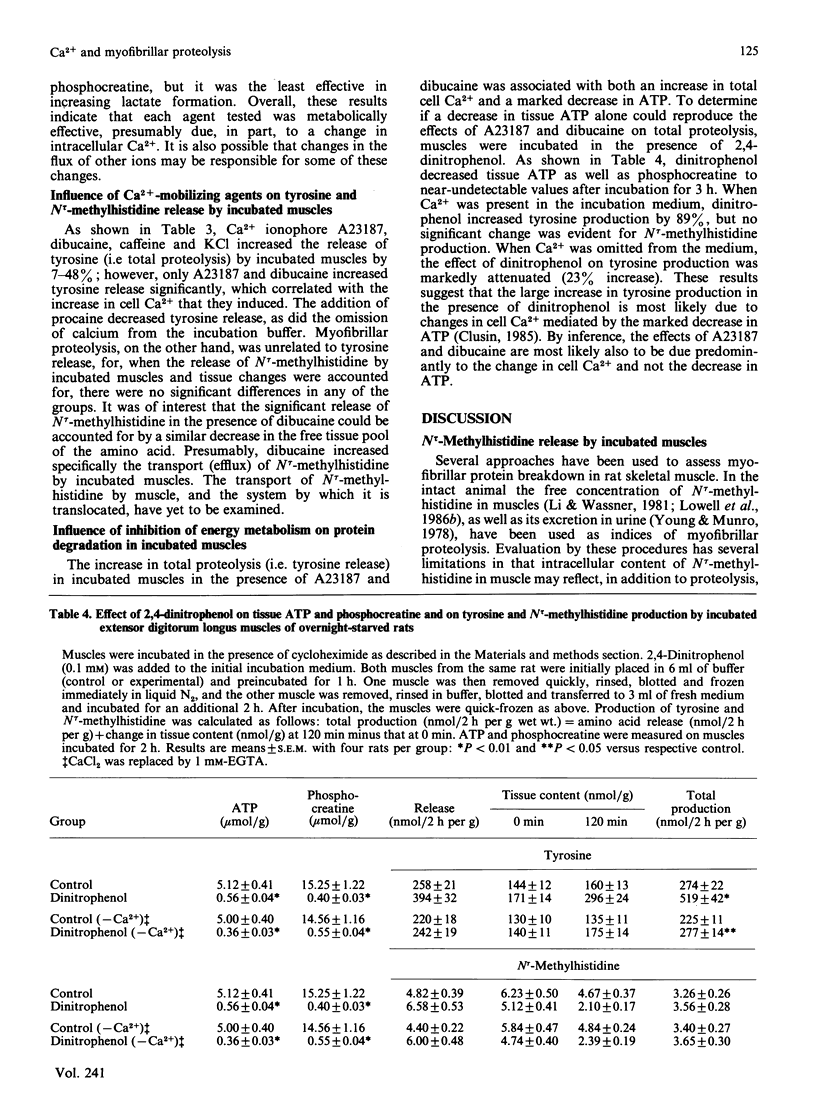Abstract
The influence of Ca2+ on myofibrillar proteolysis was evaluated in the isolated extensor digitorum longus muscle incubated in vitro with agents previously shown to increase the intracellular concentration of Ca2+. Myofibrillar proteolysis was evaluated by measuring the release of N tau-methylhistidine, and total proteolysis was evaluated by measuring tyrosine release by incubated muscles after the inhibition of protein synthesis with cycloheximide. Incubated muscles released measurable quantities of N tau-methylhistidine, and muscle contents of the amino acids remained stable over 2 h of incubation. The release of N tau-methylhistidine by incubated muscles was similar to its release by perfused rat muscle in response to brief starvation, indicating the integrity of the incubated muscles. Ca2+ ionophore A23187, dibucaine, procaine, caffeine and elevated K+ concentration increased lactate release by incubated muscles and decreased tissue contents of ATP and phosphocreatine to varying degrees, indicating the metabolic effectiveness of the agents tested. Only A23187 and dibucaine increased total cell Ca2+, and they increased tyrosine release. Caffeine and elevated [K+] increased neither cell Ca2+ nor tyrosine release; however, only A23187 and dibucaine increased tyrosine release significantly. On the other hand, these agents were without effect on myofibrillar proteolysis as assessed by N tau-methylhistidine release by incubated muscles and changes in tissue contents of the amino acid. In fact, some of the agents tested tended to decrease myofibrillar proteolysis slightly. These results indicate that acute elevation of intracellular Ca2+ is associated with increased breakdown of non-myofibrillar but not myofibrillar proteins. Because of this, the role of elevated Ca2+ in muscle atrophy in certain pathological states is questioned. The data also indicate that the breakdown of myofibrillar and non-myofibrillar proteins in muscle is regulated independently and by different pathways, a conclusion reached in previous studies with perfused rat muscle.
Full text
PDF






Selected References
These references are in PubMed. This may not be the complete list of references from this article.
- Bates P. C., Millward D. J. Myofibrillar protein turnover. Synthesis rates of myofibrillar and sarcoplasmic protein fractions in different muscles and the changes observed during postnatal development and in response to feeding and starvation. Biochem J. 1983 Aug 15;214(2):587–592. doi: 10.1042/bj2140587. [DOI] [PMC free article] [PubMed] [Google Scholar]
- Bird J. W., Carter J. H., Triemer R. E., Brooks R. M., Spanier A. M. Proteinases in cardiac and skeletal muscle. Fed Proc. 1980 Jan;39(1):20–25. [PubMed] [Google Scholar]
- Bittar E. E., Hift H., Huddart H., Tong E. The effects of caffeine on sodium transport, membrane potential, mechanical tension and ultrastructure in barnacle muscle fibres. J Physiol. 1974 Oct;242(1):1–34. doi: 10.1113/jphysiol.1974.sp010691. [DOI] [PMC free article] [PubMed] [Google Scholar]
- Bylund-Fellenius A. C., Ojamaa K. M., Flaim K. E., Li J. B., Wassner S. J., Jefferson L. S. Protein synthesis versus energy state in contracting muscles of perfused rat hindlimb. Am J Physiol. 1984 Apr;246(4 Pt 1):E297–E305. doi: 10.1152/ajpendo.1984.246.4.E297. [DOI] [PubMed] [Google Scholar]
- Clark A. S., Kelly R. A., Mitch W. E. Systemic response to thermal injury in rats. Accelerated protein degradation and altered glucose utilization in muscle. J Clin Invest. 1984 Sep;74(3):888–897. doi: 10.1172/JCI111506. [DOI] [PMC free article] [PubMed] [Google Scholar]
- Clusin W. T. Do caffeine and metabolic inhibitors increase free calcium in the heart? Interpretation of conflicting intracellular calcium measurements. J Mol Cell Cardiol. 1985 Mar;17(3):213–220. doi: 10.1016/s0022-2828(85)80004-3. [DOI] [PubMed] [Google Scholar]
- Emery A. E., Burt D. Intracellular calcium and pathogenesis and antenatal diagnosis of Duchenne muscular dystrophy. Br Med J. 1980 Feb 9;280(6211):355–357. doi: 10.1136/bmj.280.6211.355. [DOI] [PMC free article] [PubMed] [Google Scholar]
- Etlinger J. D., Goldberg A. L. A soluble ATP-dependent proteolytic system responsible for the degradation of abnormal proteins in reticulocytes. Proc Natl Acad Sci U S A. 1977 Jan;74(1):54–58. doi: 10.1073/pnas.74.1.54. [DOI] [PMC free article] [PubMed] [Google Scholar]
- Fulks R. M., Li J. B., Goldberg A. L. Effects of insulin, glucose, and amino acids on protein turnover in rat diaphragm. J Biol Chem. 1975 Jan 10;250(1):290–298. [PubMed] [Google Scholar]
- Jefferson L. S., Li J. B., Rannels S. R. Regulation by insulin of amino acid release and protein turnover in the perfused rat hemicorpus. J Biol Chem. 1977 Feb 25;252(4):1476–1483. [PubMed] [Google Scholar]
- Jenkins A. B., Whittaker M., Schofield P. J. The starvation induced increase in muscle protein degradation is non-lysosomal in origin. Biochem Biophys Res Commun. 1979 Feb 28;86(4):1014–1019. doi: 10.1016/0006-291x(79)90218-3. [DOI] [PubMed] [Google Scholar]
- Kameyama T., Etlinger J. D. Calcium-dependent regulation of protein synthesis and degradation in muscle. Nature. 1979 May 24;279(5711):344–346. doi: 10.1038/279344a0. [DOI] [PubMed] [Google Scholar]
- Kirschke H., Langner J., Wiederanders B., Ansorge S., Bohley P., Broghammer U. Intrazellulärer Proteinabbau. VII. Kathepsin L und H: Zwei neue Proteinasen aus Rattenleberlysosomen. Acta Biol Med Ger. 1976;35(3-4):285–299. [PubMed] [Google Scholar]
- Lewis S. E., Anderson P., Goldspink D. F. The effects of calcium on protein turnover in skeletal muscles of the rat. Biochem J. 1982 Apr 15;204(1):257–264. doi: 10.1042/bj2040257. [DOI] [PMC free article] [PubMed] [Google Scholar]
- Li J. B., Wassner S. J. Muscle degradation in uremia: 3-methylhistidine release in fed and fasted rats. Kidney Int. 1981 Sep;20(3):321–325. doi: 10.1038/ki.1981.141. [DOI] [PubMed] [Google Scholar]
- Libby P., Goldberg A. L. Leupeptin, a protease inhibitor, decreases protein degradation in normal and diseased muscles. Science. 1978 Feb 3;199(4328):534–536. doi: 10.1126/science.622552. [DOI] [PubMed] [Google Scholar]
- Lowell B. B., Ruderman N. B., Goodman M. N. Evidence that lysosomes are not involved in the degradation of myofibrillar proteins in rat skeletal muscle. Biochem J. 1986 Feb 15;234(1):237–240. doi: 10.1042/bj2340237. [DOI] [PMC free article] [PubMed] [Google Scholar]
- Maizels E. Z., Ruderman N. B., Goodman M. N., Lau D. Effect of acetoacetate on glucose metabolism in the soleus and extensor digitorum longus muscles of the rat. Biochem J. 1977 Mar 15;162(3):557–568. doi: 10.1042/bj1620557. [DOI] [PMC free article] [PubMed] [Google Scholar]
- Maltin C. A., Harris C. I. Morphological observations and rates of protein synthesis in rat muscles incubated in vitro. Biochem J. 1985 Dec 15;232(3):927–930. doi: 10.1042/bj2320927. [DOI] [PMC free article] [PubMed] [Google Scholar]
- Mellgren R. L. Canine cardiac calcium-dependent proteases: Resolution of two forms with different requirements for calcium. FEBS Lett. 1980 Jan 1;109(1):129–133. doi: 10.1016/0014-5793(80)81326-3. [DOI] [PubMed] [Google Scholar]
- Reed P. W., Lardy H. A. A23187: a divalent cation ionophore. J Biol Chem. 1972 Nov 10;247(21):6970–6977. [PubMed] [Google Scholar]
- Rennie M. J., Millward D. J. 3-Methylhistidine excretion and the urinary 3-methylhistidine/creatinine ratio are poor indicators of skeletal muscle protein breakdown. Clin Sci (Lond) 1983 Sep;65(3):217–225. doi: 10.1042/cs0650217. [DOI] [PubMed] [Google Scholar]
- Riejngoud D. J., Tager J. M. Measurement of intralysosomal pH. Biochim Biophys Acta. 1973 Jan 24;297(1):174–178. doi: 10.1016/0304-4165(73)90061-5. [DOI] [PubMed] [Google Scholar]
- Rodemann H. P., Waxman L., Goldberg A. L. The stimulation of protein degradation in muscle by Ca2+ is mediated by prostaglandin E2 and does not require the calcium-activated protease. J Biol Chem. 1982 Aug 10;257(15):8716–8723. [PubMed] [Google Scholar]
- Sugden P. H. The effects of calcium ions, ionophore A23187 and inhibition of energy metabolism on protein degradation in the rat diaphragm and epitrochlearis muscles in vitro. Biochem J. 1980 Sep 15;190(3):593–603. doi: 10.1042/bj1900593. [DOI] [PMC free article] [PubMed] [Google Scholar]
- Tischler M. E. Hormonal regulation of protein degradation in skeletal and cardiac muscle. Life Sci. 1981 Jun 8;28(23):2569–2576. doi: 10.1016/0024-3205(81)90713-x. [DOI] [PubMed] [Google Scholar]
- Toyo-Oka T., Shimizu T., Masaki T. Inhibition of proteolytic activity of calcium activated neutral protease by leupeptin and antipain. Biochem Biophys Res Commun. 1978 May 30;82(2):484–491. doi: 10.1016/0006-291x(78)90900-2. [DOI] [PubMed] [Google Scholar]
- WAALKES T. P., UDENFRIEND S. A fluorometric method for the estimation of tyrosine in plasma and tissues. J Lab Clin Med. 1957 Nov;50(5):733–736. [PubMed] [Google Scholar]
- Wassner S. J., Li J. B. N tau-methylhistidine release: contributions of rat skeletal muscle, GI tract, and skin. Am J Physiol. 1982 Oct;243(4):E293–E297. doi: 10.1152/ajpendo.1982.243.4.E293. [DOI] [PubMed] [Google Scholar]
- Wassner S. J., Schlitzer J. L., Li J. B. A rapid, sensitive method for the determination of 3-methylhistidine levels in urine and plasma using high-pressure liquid chromatography. Anal Biochem. 1980 May 15;104(2):284–289. doi: 10.1016/0003-2697(80)90076-7. [DOI] [PubMed] [Google Scholar]
- Young V. R., Munro H. N. Ntau-methylhistidine (3-methylhistidine) and muscle protein turnover: an overview. Fed Proc. 1978 Jul;37(9):2291–2300. [PubMed] [Google Scholar]
- Zeman R. J., Kameyama T., Matsumoto K., Bernstein P., Etlinger J. D. Regulation of protein degradation in muscle by calcium. Evidence for enhanced nonlysosomal proteolysis associated with elevated cytosolic calcium. J Biol Chem. 1985 Nov 5;260(25):13619–13624. [PubMed] [Google Scholar]


